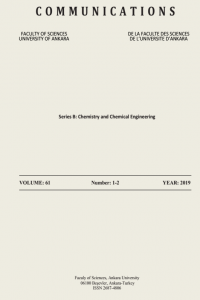The Preparation Of Stable Silver Sulphide Sols and The Investigation Of The Flocculation Effects Of Different Technical Polymers and Salts On These Sols
In this work, silver sulphide sols were prepared by the reaction between dilute silver nit- rate and sodium thiosulfate Solutions. For this purpose, Solutions were mixed in various propor- tions. Their stability w ere determined by ploıting the absorbance values measured at definite time intervals versus time. The mixtures were prepared in two series as follows: (A) Those in which silver nitrate was in excess as compared to silver thiosulfate. (B) Those in which sodium thiosulfate was in excess as compared to silver nitrate. In the cases where reagent concantrations were almost the same it was noted that sols were not stable. They were only stable when different concentrations are used and the most stab¬le silver sulphide sol is obtained when the molar concentration ratio of Na2S2Os to AgNO3 is 1,25 or greater. These are type (B) sols. It was found also that the ratios of concentrations influence the duration of sol formation. Shaking had no effect on such sols. The stabilizing effect of nitrate ions was observed in the sols where the amount of silver nitrate was more than of sodium thiosulfate. Both sols are negatively charged. The flocculating effect of anionic, cationic and non-ionic polymers and aluminium nitrate, barium nitrate salts on the sols on mentioned above were investigated. Aluminium and barium salts had a negligib- Je effect on the (A) type sols. On the other hand, the non-ionic polymers had the most floccula¬ting effect when shaken for five minutes at 170 rpm. (rotasyon per minute). In (B) type sols, aluminium and barium salts act as strong flocculating agents. Anionic, cationic and non-ionic polymers had no flocculating effect on these sols when agitated. The flocculating effect was determined from the curves obtained between the absorbances versus time at definite wavelength. It was conculuded that these sols differed from each other by their stability and flocculation with electrolytes. Micrographs might also show that their partic- les size and shapes also where different.
Keywords:
The Preparation, Stable Silver The Investigation,
___
- Communications Faculty of Sciences University of Ankara Series B Chemistry and Chemical Engineering
- ISSN: 1303-6017
- Başlangıç: 1948
- Yayıncı: Ankara Üniversitesi
Sayıdaki Diğer Makaleler
